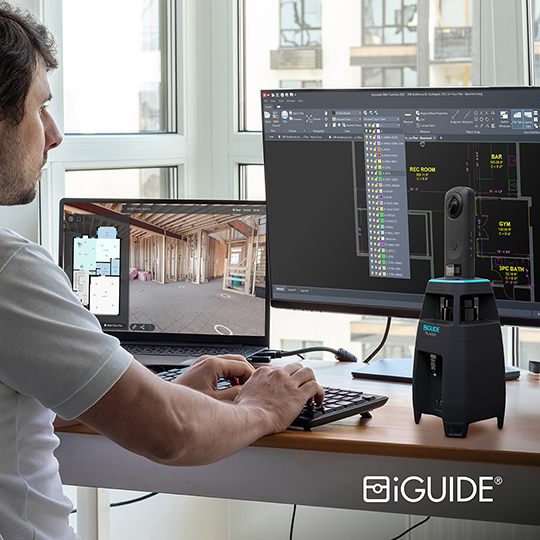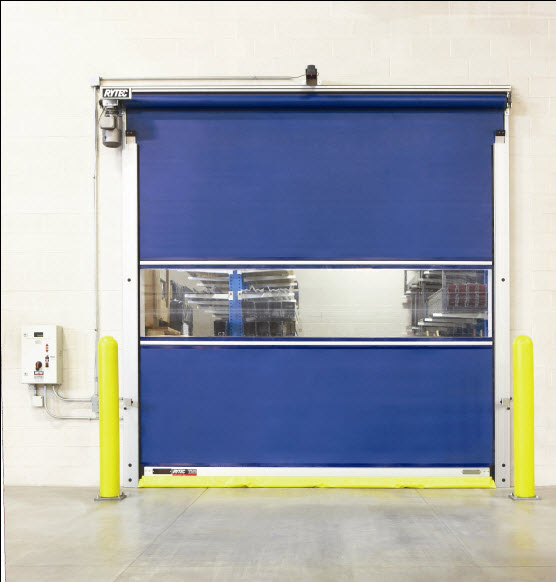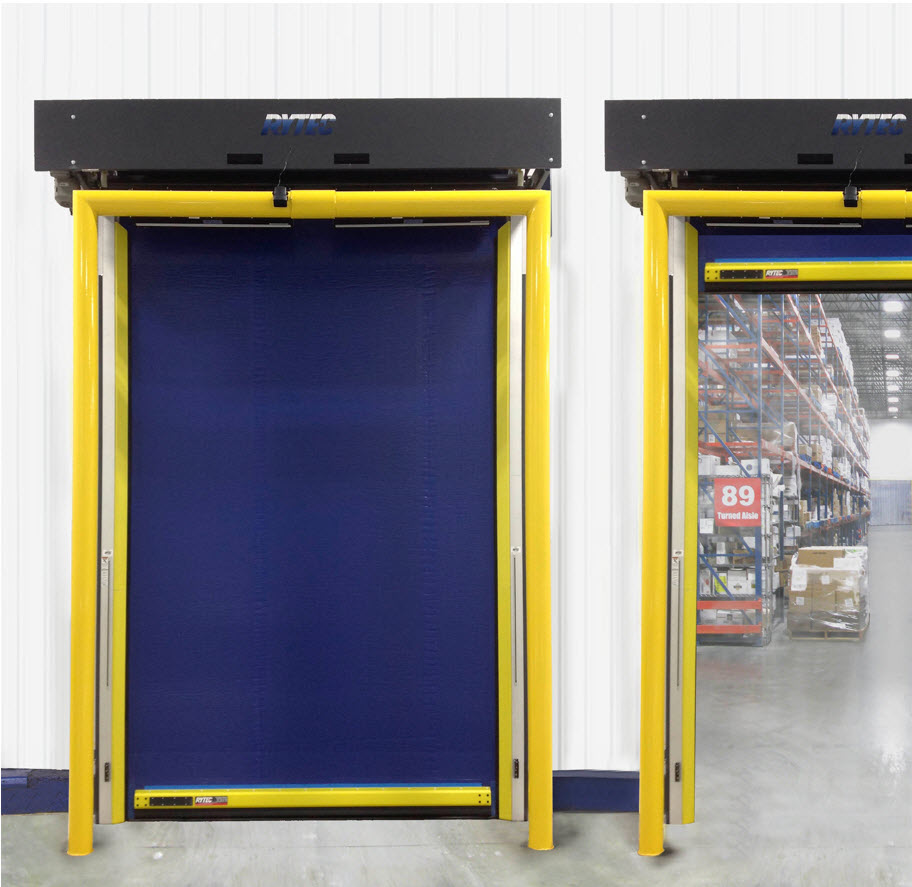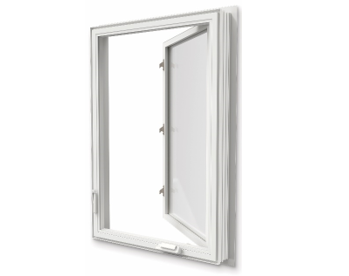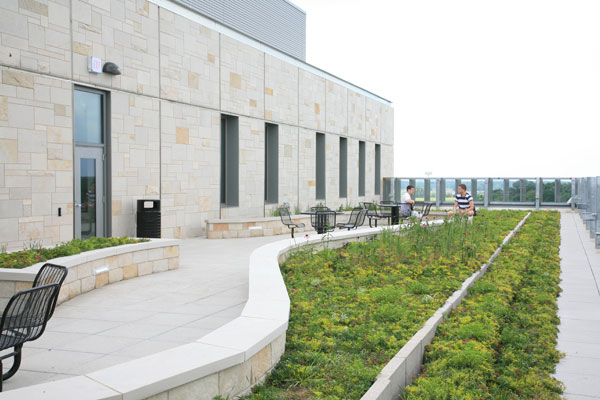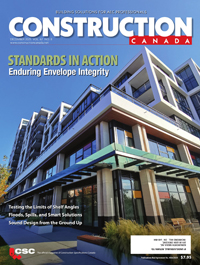Specifying weather-resistant barriers: Performance measures for building wraps
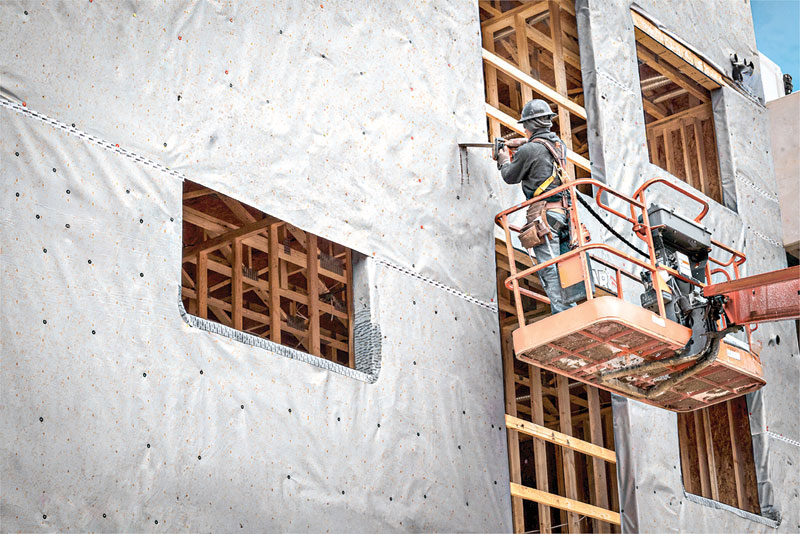
In recent years, moisture management has become increasingly important for multifamily and commercial construction teams due to higher expectations for building performance and more stringent building codes and regulations. Many materials and installation practices contribute to air- and moisture-resistant building envelopes, with weather-resistant barriers playing a pivotal role.
Although the 2018 International Building Code (IBC) sets a prescriptive baseline for weather-resistant barriers (WRB) (e.g. one layer of No.15 asphalt felt), modern building science—and both U.S. and Canadian codes—now emphasize performance-based standards. In practice, a high-performing WRB must strike a balance of four key properties: bulk water holdout, air resistance, vapour permeability, and durability. While many WRBs are also vapour-permeable to allow outward drying, not all are, and not all assemblies require vapour-permeable layers. The optimal choice depends on climate, cladding type, and the drying strategy of the wall assembly. In Canada, performance is evaluated through CAN/ULC-S741 and S742 rather than by material type.
The performance of a WRB depends on the material’s ability to maintain its integrity, no matter what comes into contact with it. This article will define the WRB performance characteristics specifiers need to know about and outline key tests and certifications that can help ensure the right material is selected for the project.
Clarifying terminology
Weather-resistant barriers (WRB), air barrier, or building wrap? These terms are often used interchangeably, but they serve different roles in the building envelope:
- Weather-resistant barrier (WRB): Resists bulk water intrusion and may also limit air and vapour movement depending on the product and application.
- Air barrier membrane: Designed and tested to limit air leakage through the enclosure; may or may not serve as a WRB.
- Building wrap: A sheet-applied WRB (often polymer-based) that may function as an air barrier if properly sealed and installed as part of a continuous system.
Moisture management and drainability
As its most basic function, a WRB must hold out water. A high-performance building wrap will be able to pass both a “water ponding” test, which measures a building wrap’s resistance to a 25.4-mm (1-in.) pond of water over two hours, and a more stringent hydrostatic pressure test where the material is subjected to a pressurized column of water for five hours.
However, as the trend for tighter building assemblies continues to grow, building wraps must be able to balance permeability with drainability to both prevent water from becoming trapped in the wall and allow any moisture that does become trapped to evaporate effectively.
The drainage efficiency of a building wrap is generally tested in accordance with ASTM E2273, Standard Test Method for Determining the Drainage Efficiency of Exterior Insulation and Finish Systems (EIFS) Clad Wall Assemblies. During the ASTM E2273 test, a spray box with two small openings for water application is sealed to a wall assembly. Next, water is sprayed onto the wall for 75 minutes, with the water collected measured at 15-minute intervals. Water flow and dispersion are held constant throughout the test.
Once the 75 minutes are up, the wall sits idle for an additional hour before measuring the collected water drained from the wall assembly. If greater than 90 per cent of the total applied water has drained and been collected, the wall assembly is said to be in accordance with ASTM E2273. Section R703.9.2 of the 2018 International Residential Code (IRC) and Section 1407.4.1 of the 2018 IBC require the wall to have an average minimum drainage efficiency of 90 per cent when tested in accordance with ASTM E2273.
The National Building Code of Canada (NBC) does not have a minimum level of water resistance; it only requires that materials meet standards of pliability, tensile strength, and water vapour permeance. However, for materials to be voluntarily certified by the Canadian Construction Materials Centre (CCMC), they must pass a third test included in “Technical Guide for Sheathing, Membrane, Breather-Type,” paragraph 6.4.5, in which a WRB is subjected to water for two hours at a depth of 25.4 mm (1 in.).1
Given the proliferation of drainable building wraps on the market, builders and specifiers should pay close attention to how quickly bulk water drains, as it can vary significantly. Some high-performance building wraps have been shown to achieve drainage efficiency of greater than 90 per cent, according to ASTM E2273, and some leverage innovative technologies to take this even higher.
Today’s most advanced building wrap products feature integrated drainage gaps through creping, embossing, weaving, or filament spacers. These new products eliminate the need for furring strips, helping reduce material costs and streamline installation. The cutting-edge drainable building wrap technology are products that create a drainage gap through an additional layer of polypropylene fibres. One of the leading commercial drainable building wraps uses this technology to create a drainage gap and has achieved 96.7 per cent drainage efficiency per ASTM E2273 while still handling and installing like a standard building wrap.
This added layer of protection is particularly important in coastal climates and areas subject to heavy wind-driven rainfall. These products can be installed in any direction without affecting performance.
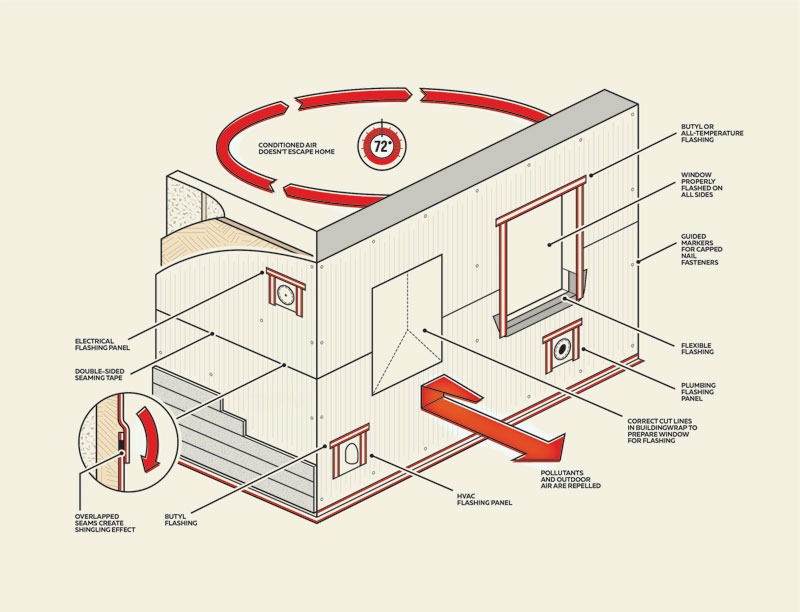
Permeability
A WRB must be able to breathe to prevent moisture vapour from getting trapped in the wall assembly. Permeability measures the amount of vapour transmission that a building wrap will allow over a period of time. ASTM E96/E96M, Standard Test Methods for Gravimetric Determination of Water Vapor Transmission Rate of Materials, addresses two testing procedures for measuring permeability—desiccant and water methods.
In the desiccant method, the material to be tested is sealed to a test dish containing a desiccant or drying agent, and the assembly is placed in a controlled atmosphere. Periodic weighing determines the rate at which water vapour has moved through the specimen into the desiccant. In the water method, the dish contains distilled water, and periodic weighing determines the rate of vapour movement through the specimen from the water.
In most wall assemblies, outwardly driven moisture will not cause many problems (unless one is dealing with a material such as stucco painted with a low-perm paint, in which case bubbling and cracking would be visible). However, the inwardly driven moisture presents a problem, especially when conditioned indoor air is much cooler than the warm, moist exterior. However, this is not the case in colder Canadian climates during long winter months, where the primary concern is outward vapour drive—from warm, moist indoor air moving toward the cold, dry exterior. As this moisture travels through the wall assembly, it may reach its dew point and condense on the first cold surface. If this occurs within the wall in an uncontrolled manner, the resulting trapped water can damage insulation, sheathing, and framing materials. These risks are addressed under the NBC, Part 5, which outlines requirements for environmental separation, including control of vapour diffusion and condensation within the building envelope.
This highlights the importance of selecting and positioning the vapour control layer appropriately within the wall assembly. In assemblies using a vapour-permeable WRB combined with an impermeable sheathing material such as extruded polystyrene (XPS), water vapour can initially pass through the WRB but will be blocked at the XPS layer. If condensation occurs at this interface, the assembly must be designed to either drain accumulated moisture downward or allow drying toward the interior, depending on climate zone, wall configuration, and material properties. The vapour control layer plays a critical role in both limiting further moisture transmission into the wall and supporting drying over time, especially during
seasonal transitions.
Typically, inwardly driven moisture vapour is managed by separating the cladding from the rest of the assembly with a capillary break, a gap, or a sheathing material able to shed, resist, or redirect water. Impermeable sheathing, such as XPS, is one option for halting vapour migration. In these assemblies, inward vapour condenses on the XPS surface and, if properly detailed, drains downward.
However, in situations where a reservoir cladding is paired with a highly permeable sheathing like gypsum board (which can be as high as 50 perms) or a moisture-retentive material such as oriented strand board (OSB), an air gap may not be enough to slow vapour intrusion. In these applications, a well-selected WRB with suitable permeability is essential to reduce unwanted moisture accumulation while allowing the assembly to dry effectively.
The International Code Council (ICC) mandates that a product’s permeance rating must be higher than five perms to be considered a WRB and not a vapour retarder. There are various ways to achieve permeability; however, a higher perm rating does not always mean better performance. In Canadian wall assemblies, products within the 10 to 20 perm range often strike the best balance between protection from moisture intrusion and outward drying potential, especially when assemblies are designed according to NBC and CAN/ULC-S741 performance standards.
“Inward Drive – Outward Drying,” a paper written by building scientist Joseph Lstiburek,2 recommends that specifiers aim for the “sweet spot” of 10–20 perms to achieve the desired moisture protection and breathability balance. Achieving the optimal perm rating ensures that while water is prevented from entering the wall cavity, ideal levels of moisture vapour are still allowed to escape. He writes that if it is too high, the moisture driven out of the back side of a reservoir cladding, such as brick or stucco, into the air space will blow through the layer and the permeable sheathing into the wall cavity. Too low, and the outward drying potential of the cavity is compromised. Fortunately, building wrap technology, mainly using a “systems” approach, can help builders hit the sweet spot for permeance.
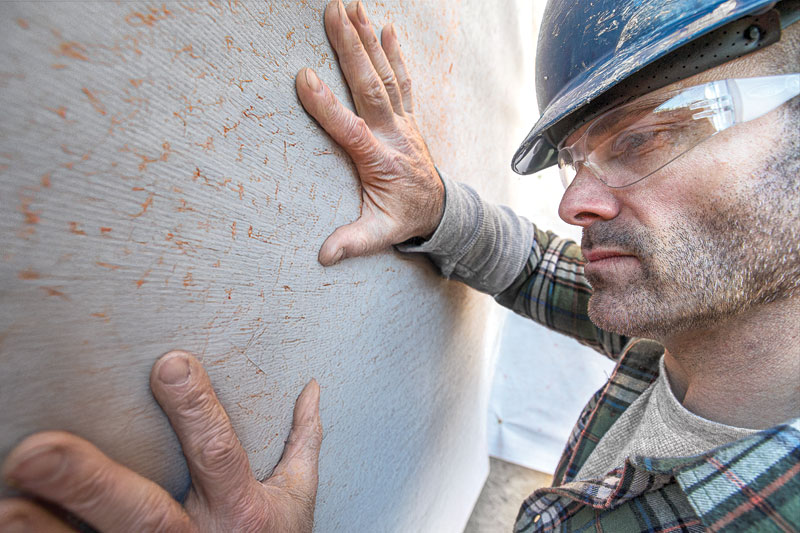
Air holdout
The Air Barrier Association of America (ABAA) defines an air barrier as a system of assemblies within the building enclosure—designed, installed, and integrated in such a manner as to stop the uncontrolled flow of air into and out of the enclosure. For several reasons, it is important to establish a continuous air barrier. As an air barrier isolates the indoor environment, it plays a significant role in the overall energy efficiency, comfort, and indoor air quality (IAQ) of a building. According to Natural Resources Canada (NRCan), air leakage represents about 20 to 30 per cent of heat lost from an older home, costing a homeowner $250 to $1,000 per year.3 A continuous air barrier reduces heating and cooling costs, lowering greenhouse gas (GHG) production.
For an individual building material to be classified as an air barrier, its air permeance must be equal to or less than 0.02 L/(s•m2) at 75 Pa (0.00394 cfm/sf at 1.57 psf) when tested following ASTM E2178, Standard Test Method for Determining Air Leakage Rate and Calculation of Air Permeance of Building Materials. However, this air permeance test only measures the amount of air migrating through the material itself, not through holes or gaps in the larger assembly. Therefore, it is important to consider a material’s effectiveness as an air barrier largely depends on proper installation and the use of compatible tapes, fasteners, and sealants.
Understanding how an air barrier material performs when installed as part of a compatible system is much more valuable. To receive approval from ABAA, an air barrier must pass the organization’s air leakage standards when tested in accordance with ASTM E2357, Standard Test Method for Determining Air Leakage Rate of Air Barrier Assemblies. This type of test is intended to more accurately replicate how a wall system will perform in a real-world setting. It includes various elements, such as wind loading, making it a more reliable measure of the system’s performance. When tested in accordance with this standard, the air barrier’s tested air leakage must be less than or equal to 0.20 L/(s•m2) @ 75 Pa (0.04 cfm/sf @ 1.57 psf) in both directions (i.e. infiltration and exfiltration).
Air barriers can also be defined through whole-building testing in accordance with ASTM E779, Standard Test Method for Determining Air Leakage Rate by Fan Pressurization. This test method is intended to measure the airtightness of building envelopes of single-zone buildings. For this test method, many multi-zone buildings can be treated as single-zone structures by opening interior doors or inducing equal pressures in adjacent zones.
To align with Canadian codes and product evaluation practices, CAN/ULC-S741 and CAN/ULC-S742 are the two key standards used to assess air barrier performance—S741 for individual materials, and S742 for full assemblies. While these standards are specifically written for air barriers, they are frequently applied to commercial-grade WRBs when those products are intended to function as both moisture and air control layers. In such dual-role applications, WRBs are tested to meet air permeance and assembly leakage criteria under S741 and S742, in addition to separate evaluations for moisture management, such as ASTM E96 (vapour permeance), E2273 (drainage), and E2357 (assembly air leakage). However, it is important to note that S741 and S742 do not directly test water holdout, so WRBs must also be validated through dedicated water resistance testing.
This reinforces the industry’s growing emphasis on assembly-level testing, where the combined performance of WRBs, flashings, tapes, windows, rainscreens, and sheathing is assessed as a system. As codes continue to evolve, proactive product design and verified system compatibility are becoming essential for meeting the increasingly stringent building envelope performance requirements found in both the IBC and the NBC.

Taking a system approach
The key word in this discussion is assembly. A WRB material alone—no matter how advanced—cannot be counted on to protect a structure from unwanted air and moisture movement without considering the whole assembly. It is important to specify compatible materials to ensure all components work together.
For example, sealants with high solvent or plasticizer content can damage bitumen flashing products, causing functional and esthetic issues. When seams and tears are not adequately taped, windblown rain can infiltrate the assembly. Failure to use galvanized roofing nails or plastic cap nails to attach the WRB to the sheathing and framing can also compromise performance.
To counter this problem, some manufacturers have developed a system approach that includes compatible tapes for seaming and adhesive flashings for openings. When installed together, these systems are often assured through extended warranties from the manufacturer. When in doubt, always check the manufacturer’s website for additional guidance.
Durability
Construction sites can be challenging, and if the building wrap is not tested to withstand tears, scratches, prolonged exposure to UV light, and common construction chemicals, it will not perform how it needs to once installed.
When it comes to building wrap, the ICC tests durability on two primary indicators: tensile strength and tear resistance. These factors are critical because the wrap needs to withstand the handling and installation process without compromising its air- and water-resistive properties.
Tear resistance, as measured by trapezoidal tear tests (ASTM D1117/ASTM D5733), is a good measure for predicting a building wrap’s ability to withstand the rigours of the job site and to stay on the wall after installation. “In-plane” is the best measurement of tear resistance. The trapezoid tear test, the best measurement of in-plane tear resistance, takes place when the building wrap is fastened to the wall and is subjected to tearing in the plane of the wall.
Some building wraps claim tensile strength based on ASTM D882, a test for thin plastic sheeting, not nonwoven fabrics. Since the product is never used this way, these measurements are not meaningful. However, the grab tensile measurement is meaningful. ASTM D5034, Standard Test Method for Breaking Strength and Elongation of Textile Fabrics (Grab Test), tests a 1.2 x 1.8 m (4 x 6 ft) material sample and clearly states it is designed for nonwoven fabrics, making it a much better metric for evaluating building wraps.
Another factor to consider is the ability of a building wrap to withstand incidental scratches from utility knives, nails, and other tools. While no ASTM standards govern scratch resistance testing for building wraps, some manufacturers commission third-party testing to demonstrate the performance of their products. A scratch-resistant wrap is less likely to suffer from surface damage that could weaken the material, ensuring it lasts longer and continues to perform effectively. Therefore, it is important to ensure the wrap being used has been tested for scratch resistance.
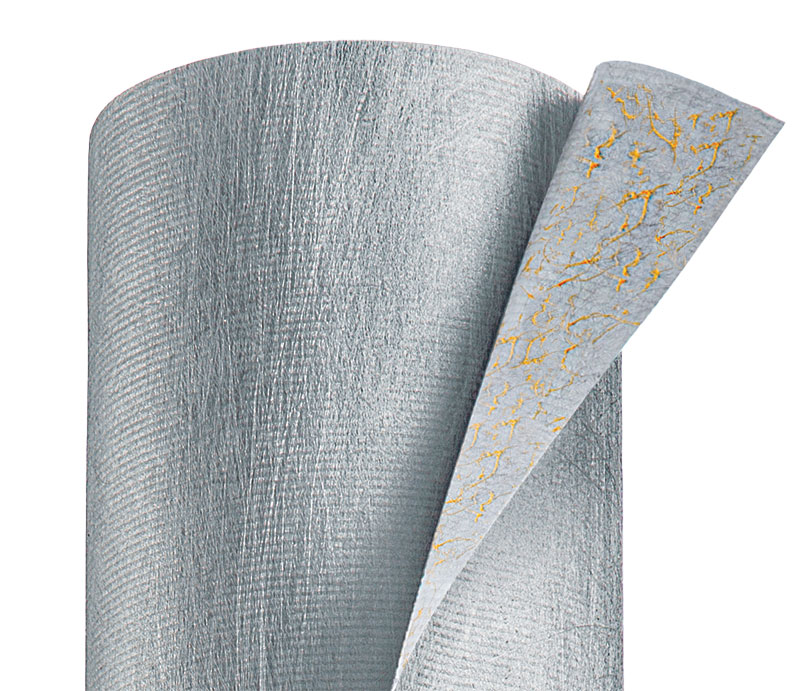
UV resistance
Another primary performance attribute in a high-performance WRB is its ability to stand up to UV exposure. This is a critical point of differentiation between weather barriers, as prolonged exposure to UV radiation can cause material degradation, leading to loss of tensile strength, delamination of surface layers, and reduced water repellency. This is especially true in commercial construction, where there are already prolonged construction schedules that are often slowed by several factors. For these reasons, UV exposure of foremost consideration when selecting a system of weather protection products.
While the goal should be to clad the exterior of the building as quickly as possible, projects are often delayed, leaving WRBs vulnerable to longer-than-expected exposure to the sun.
Many building wraps currently on the market only offer up to 120 days of UV resistance, with the best offering up to 12 months without degradation to their performance capabilities. This can be an incredibly important differentiator for commercial projects where extended project timelines often leave the WRB exposed for a considerable amount of time.
Surfactant resistance
When evaluating WRBs, specifiers should seek an optimal balance of performance characteristics, including air and water resistance, durability, and sufficient permeability. However, one property, surfactant resistance, is commonly overlooked by building professionals. Builders and contractors who do not have a basic understanding of surfactants and how they impact the performance of a building wrap could potentially jeopardize the long-term durability of the exterior wall assembly.
Surfactants (surface active agents) are contaminants that lower the surface tension of a liquid, allowing it to penetrate deeper into the WRB material. Water soluble extractives in wood, such as tannins and wood sugars in redwood and cedar, are examples of surfactants that contaminate the surface of building wraps. In addition, surfactants can be found in detergents, soaps, and other cleaning solutions used to power wash siding, making surfactants almost impossible to avoid.
Why is this a problem? Surfactants promote the loss of water repellency, causing “wetting” of the building wrap surface. Once this occurs, water can more easily pass through the microscopic openings in the building wrap. Once moisture finds its way into the building envelope, it can threaten its structural integrity, causing exterior surfaces to deteriorate. Bulk moisture intrusion can also support mould and rot, which cause structural damage and pose serious health hazards to building occupants.
When choosing a building wrap, pay attention to its surfactant resistance capabilities. Not all wraps will provide the same surfactant protection, if any at all. Recent testing conducted by an accredited third-party testing facility with ISO 17025, Miami-Dade, American Architectural Manufacturers Association (AAMA), and AABA certifications compared three well-known weather-resistant barriers when subjected to a common surfactant (dish soap and water) and revealed that one outperformed the other two across the board.3
Although it is never advisable to expose WRBs to surfactants, most will be exposed despite best intentions. So, builders and contractors must select a wrap resistant to these chemicals. Due to the vast amount of building wraps and moisture management products on the market, it is more imperative than ever to make the right product selections to design and build wall systems that perform to today’s high performance, durability, and moisture control standards.
Conclusion
Specifying the right WRB is critical for achieving a high-performance building envelope that meets today’s stringent building codes. Understanding the key performance measures—such as moisture management, permeability, air holdout, durability, UV resistance, and surfactant resistance—ensures a building wrap that protects against the elements and enhances the overall longevity and energy efficiency of the structure. Taking a systems approach and specifying WRB materials that strike an optimal balance between these various performance characteristics ensures informed decisions that contribute to the success and sustainability of projects.
Notes
1 See Thomas K. Butt, FAIA. “Water resistance and vapour permeance of weather-resistive barriers.” Journal of ASTM International, Vol. 2, No. 10, November/December 2005. Paper ID JAI12495. For more, visit www.astm.org.
2 Refer.
3 Refer.
Today’s most advanced building wrap products feature integrated drainage gaps through creping, embossing, weaving, or filament spacers. These new products eliminate the need for furring strips, helping reduce material costs and streamline installation.
Author
Andrew Irvine is a senior product manager at TYPAR Construction Products. He has extensive experience in the building and construction industry, including global product management, national account management, and finance. Irvine is responsible for the building and construction portfolio, including the TYPAR product line.




